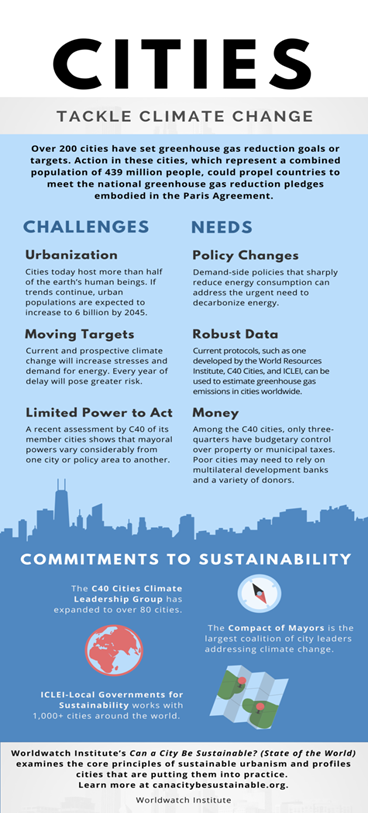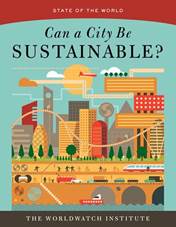 Global Issues >> Environment >> Climate Change Hundreds of Cities Commit to Combating EmissionsBy Gaelle Gourmelon, World Watch Institute June 6, 2016
Over 200 cities have set greenhouse gas reduction goals or targets. Action in these urban areas, which represent a combined population of 439 million people, could propel countries to meet their Intended Nationally Determined Contributions (INDCs)—the national greenhouse gas reduction pledges embodied in the Paris Agreement. According to Can a City Be Sustainable?, the latest edition of State of the World, cities and their inhabitants are playing a lead role in achieving global climate action goals. “The challenge over the next several decades is an enormous one,” write Michael Renner and Tom Prugh, contributing authors and co-directors of the report. “This requires not change around the edges, but a fundamental restructuring of how cities operate, how much they consume in resources and how much waste they produce, what they look like, and how they are structured.” The challenge over the next several decades is an enormous one. Growing numbers of cities have pledged themselves to climate commitments and sustainability goals. The C40 Cities Climate Leadership Group has expanded to over 80 cities. The Compact of Mayors, launched at the 2014 United Nations Climate Summit, is the largest coalition of city leaders addressing climate change. ICLEI–Local Governments for Sustainability works with more than 1,000 cities around the world. Cities today host more than half of the earth’s human beings and represent about 70 percent of global energy consumption and greenhouse gas emissions. If trends continue, urban populations are expected to increase to 6 billion by 2045, at which point two-thirds of all people will live in urban environments. “If current trends in urbanization continue unabated, urban energy use will more than triple, compared to 2005 levels, by 2050,” write Renner and Prugh. It is no surprise that cities collectively account for a large share of greenhouse gas emissions, because they concentrate economic activity. But cities vary widely in their per capita emissions. Rotterdam in the Netherlands, for example, emits 29.8 tons of carbon dioxide-equivalent per capita where Paris emits just 5.2 per capita (2005). Many variables, such as climate, urban form, and primary energy source, affect a city’s level of emissions. Economic factors, such as the wealth and income of residents and the level and structure of economic activity, also play a major role. “Only demand-side policies that succeed in sharply reducing energy consumption in transport, buildings, waste handling, and agriculture can address the urgent need to decarbonize energy,” write Renner and Prugh. “It is cities that must step up to the front lines of that battle.” In conjunction with policy changes, cities’ success will depend on having both comprehensive data and financial support. Current protocols, such as one developed by the World Resources Institute, C40 Cities, and ICLEI, can be used to measure or estimate greenhouse gas emissions in cities worldwide. Financing urban sustainability may be easier in some cities than in others. Among the C40 cities, only three-quarters have budgetary control over property or municipal taxes. In poorer cities, multilateral development banks and a variety of donors may play an important role.
Can a City Be Sustainable? In the newly released State of the World book, Can a City Be Sustainable?, experts from around the globe examine the core principles of sustainable urbanism and profiles cities that are putting these principles into practice. Throughout, readers discover the most pressing challenges facing communities and the most promising solutions currently being developed. The result is a snapshot of cities today and a vision for global urban sustainability tomorrow.
|
 Through bold climate commitments, cities
around the world are taking the lead on climate action.
Through bold climate commitments, cities
around the world are taking the lead on climate action. This analysis is excerpted from the chapter “Cities
and Greenhouse Gas Emissions: The Scope of the Challenge” in the Worldwatch
Institute’s Can a City Be Sustainable? By Tom Prugh, Michael Renner
This analysis is excerpted from the chapter “Cities
and Greenhouse Gas Emissions: The Scope of the Challenge” in the Worldwatch
Institute’s Can a City Be Sustainable? By Tom Prugh, Michael Renner